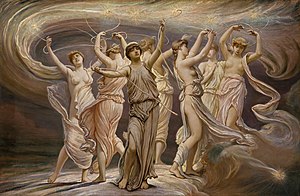Pleiades (mythology)
The Pleiades were considered nymphs in Greek mythology . They are the daughters of the Titan Atlas and the Oceanid Pleione . Due to their descent from Atlas, they are also known as the Atlantids .
myth
They were called the virginal companions of Artemis , whom Orion chased across the meadows of Boeotia until they were transformed into doves ( peleiades ) and placed in the sky as a constellation (see Pleiades ).
According to another narrative, saddened by the death of their brother Hyas , all of them took their own lives with their sisters, the Hyads , before they were lifted to heaven.
The Pleiades flew out as pigeons to bring the ambrosia to Zeus . They had to fly through the rock gate that the Argo had to pass through - the Plegades or Symplegaden . One of these pigeons always paid for this through-flight with their life - and was replaced by Zeus in each case - perhaps in order to fully hold the "seven stars" named after them .
Merope, the only Pleiad who married a mortal, played a major role in the fact that Sisyphus was once sent back from Hades , but was ultimately ashamed of this connection so that it shines weaker in the sky than her sisters.
Their names are:
- Alkyone , Halcyone : through Poseidon, the mother of Hyrieus and Aithusa , the leader of their sisters
- Asterope or Sterope : through Ares the mother of Oinomaos or his wife
- Elektra : through Zeus, the mother of Dardanos and Iasion
- Kelaino : through Poseidon, the mother of Lycus
- Maia : by Zeus the mother of Hermes , that of Callisto was close to
- Merope : through Sisyphus the mother of Glaucoma
- Taygete : through Zeus, the mother of Lacedaemon , the ancestor of the Spartans
See also
literature
- Johannes Ilberg : Pleiades . In: Wilhelm Heinrich Roscher (Hrsg.): Detailed lexicon of Greek and Roman mythology . Volume 3.2, Leipzig 1909, Sp. 2549-2560 ( digitized version ).
- Hans Georg Gundel : Pleiades. In: Paulys Realencyclopadie der classischen Antiquity Science (RE). Volume XXI, 2, Stuttgart 1952, Col. 2485-2523.
Web links
- Pleiades in the Theoi Project (English)
